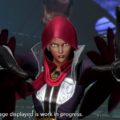Fighting Games Friday: The King of Fighters for 25 Years

It was over 25 years ago when SNK introduced The King of Fighters series, which has since become one of the longest-running fighting game franchises around. It’s a testament to how strong the brand has become since the first installment, and why it’s continued on through SNK’s financial ups and downs over the years.
It all began in ‘94 with The King of Fighters ’94, partially born from the idea to make the “king” of SNK’s fighting games. It featured the main characters from two of their biggest titles at the time: Fatal Fury and Art of Fighting.

The main three Fatal Fury characters were among the cast, Terry Bogard, Andy Bogard, and Joe Higashi, along with Ryo Sakazaki, Robert Garcia, and Takuma Sakazaki from AOF, and brought other characters from those franchises with them. The familiar faces were bridged together with brand-new characters to distinguish KOF as a new franchise separate from SNK’s other fighters. Kyo Kusanagi was the centerpiece, alongside Athena Asamiya and final boss Rugal Bernstein. It also ignored the time difference between the FF and AOF franchises to ensure that everyone could join the game at their iconic (at the time, anyway) younger ages.
It was also the “king” of fighters due to how large its cast was compared to the competition at the time. KOF94’s roster count stood at 24 (25 including Rugal) with players choosing teams of three to face off with each other. The number of choices was mind-blowing and overwhelming compared to other fighters in the mid-90s, games with roster counts in the teens at most. It was a semi-predecessor to the likes of Capcom’s later Vs. games (which eventually included SNK), Street Fighter Alpha 3, and Super Smash Bros., and showed how players liked games with a wide variety of characters to choose from. The character count for each game has only continued to rise since then. The most recent installment, The King of Fighters XIV, launched with a whopping 50 characters — not including the DLC entries. Good luck topping that with the next game.

The other aspect that cemented the franchise as a “king” was how it was the only one to have yearly installments (not updates like the Street Fighter II games), with SNK taking the sports game approach and running with it. This lasted until this became unfeasible thanks to rising game development costs and company difficulties. The series switched to numbered installments starting with The King of Fighters XI, which removed the burden of creating yearly games from their shoulders and let them focus on other popular franchises like Samurai Shodown and Metal Slug.
The franchise wouldn’t have gone anywhere if SNK hadn’t continued to introduce several appealing characters, including Iori Yagami, Leona Heidern, Shermie, K’ (pronounced “K Dash”), Kula Diamond, Ash Crimson, and several more. Several come and sometimes go as part of the franchise’s sagas, in a story that’s good by fighting game standards. Characters like Kyo, Iori, Ryo, Terry, and Athena have been staples since they were introduced, and it’s hard to imagine a title being made without them. The characters would have been nothing it wasn’t for their appealing designs and sprite work, and the animations they showcase in the face of a rival — especially between Kyo and Iori. They’ve yet to achieve this visually with the transition to 3D models, but they’ll get there.

Matches in the KOF games are fast-paced and combo-heavy compared to SNK’s other fighters, to keep its three-on-three matches moving at a good speed. The systems in the early games were basic compared to the more complicated mechanics introduced in newer installments, though newer games are inconsistent in terms of complexity. The one dependable constant is how the series has still remained approachable for casual players who’ve been with the franchise over the last 25 years, or those who want to try the series for the first time — though they’re not easy to master.
In addition to making cast changes between installments, SNK also alters character move sets to make each title feel like more than an upgrade. This sometimes happens for plot reasons, like when Iori lost his power; but others, like Robert suddenly becoming a charge character, can happen between sagas. Each installment also has different (or, at the very least, altered) music and backgrounds. The combination of these elements made it tough for anyone to complain that they were playing the same game over and over again when each title relied on the same sprites. They put a lot of work into distinguishing the titles, which makes it worth showing up for each installment.
The gimmicks over the years have also distinguished the games, even though some haven’t always worked out. The games of the NESTS Saga, for instance, added the Strikers mechanic that worked somewhat similar to assists in other tag team games. They also helped players create dastardly highly damaging and high-execution combos. The King of Fighters 2003 and XI embraced tag team mechanics, which was incredibly fun despite how it allowed for some long combos. Hopefully they give that another shot in the future.

Another unique element that’s kept KOF going in a different way compared to other fighters involves how it’s achieved popularity in unlikely territories. It’s popular in its home country of Japan, but also took off in Asian territories like China, Hong Kong, and South Korea. Most interesting is its popularity in Latin America, which it achieved thanks to how SNK machines were everywhere in Mexico and South America in poorer and middle-class neighborhoods in the 1990s. Kids back then grew up with SNK games, especially KOF. It’s why the franchise has introduced more Latin American characters over the years, and introduced distinct Mexican and South American teams in KOFXIV.
After 25 years, the King of Fighters franchise still has a bright future ahead for it, now that SNK is developing games full time again. The King of Fighters XV was announced at Evo 2019 for a possible release next year. Though KOFXIV’s didn’t quite nail a style on par with the company’s best sprite-based work, their character modeling work in the recent Samurai Shodown title suggests the next KOF game will look much better — potentially with models they can continue using for several years.





